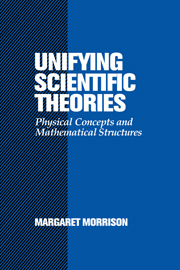Book contents
- Frontmatter
- Contents
- Acknowledgements
- Introduction
- 1 The Many Faces of Unity
- 2 Unification, Realism and Inference
- 3 Maxwell's Unification of Electromagnetism and Optics
- 4 Gauges, Symmetries and Forces: The Electroweak Unification
- 5 Special Relativity and the Unity of Physics
- 6 Darwin and Natural Selection: Unification versus Explanation
- 7 Structural Unity and the Biological Synthesis
- Conclusions
- Notes
- References
- Index
2 - Unification, Realism and Inference
Published online by Cambridge University Press: 06 October 2009
- Frontmatter
- Contents
- Acknowledgements
- Introduction
- 1 The Many Faces of Unity
- 2 Unification, Realism and Inference
- 3 Maxwell's Unification of Electromagnetism and Optics
- 4 Gauges, Symmetries and Forces: The Electroweak Unification
- 5 Special Relativity and the Unity of Physics
- 6 Darwin and Natural Selection: Unification versus Explanation
- 7 Structural Unity and the Biological Synthesis
- Conclusions
- Notes
- References
- Index
Summary
The question that occupies most of this chapter is whether or not the first word in the title – unification – bears any relation to the other two, and if so, how that relation ought to be construed. As mentioned in the introductory remarks, a common approach to fleshing out the notion of unification is to link it to explanation. A unified theory is thought to be one that can explain phenomena from different domains by showing either that the phenomena are essentially the same (e.g., light waves are simply electromagnetic waves) or that diverse phenomena obey the same laws, thereby suggesting some link between them. This explanatory power supposedly provides good evidence that the theory is true; hence, the best explanation, which typically will be the one that reveals some unity among the phenomena, should be seen as more likely to be true than its competitors. Of course, not all “best explanations” will perform a unifying function. There may be only one explanation of a particular phenomenon, and hence, by default, it will have to be considered the best. So embedded in the debate are two issues, one linking unity to explanatory power, and the other linking the concept of “best explanation” to increased likelihood of truth. This practice of drawing inferences to truth on the basis of explanatory power has been dubbed “inference to the best explanation” (IBE) and has been advocated by, among others, Harman (1965) and Thagard (1978).
More recently, however, there have been forceful criticisms by van Fraassen (1980), Cartwright (1983) and Friedman (1983) of the link between IBE and truth and its use as a methodological rule that forms the basis for inference.
- Type
- Chapter
- Information
- Unifying Scientific TheoriesPhysical Concepts and Mathematical Structures, pp. 35 - 61Publisher: Cambridge University PressPrint publication year: 2000



